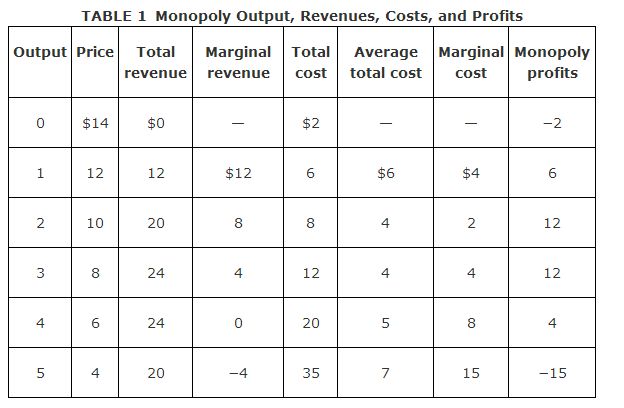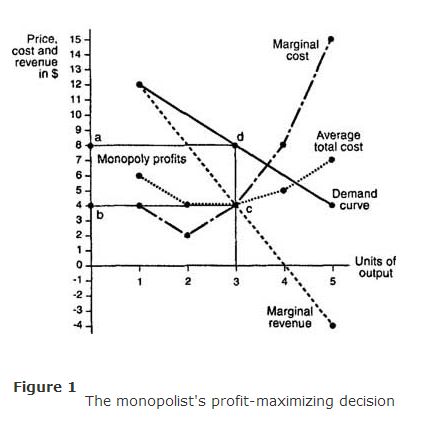The monopolist's profit maximizing level of output is found by equating its marginal revenue with its marginal cost, which is the same profit maximizing condition that a perfectly competitive firm uses to determine its equilibrium level of output. Indeed, the condition that marginal revenue equal marginal cost is used to determine the profit maximizing level of output of every firm, regardless of the market structure in which the firm is operating.
In order to determine the profit maximizing level of output, the monopolist will need to supplement its information about market demand and prices with data on its costs of production for different levels of output. As an example of the costs that a monopolist might face, consider the data in Table . The first two columns of Table represent the market demand schedule that the monopolist faces. As the price falls, the market's demand for output increases. The third column reports the total revenue that the monopolist receives from each different level of output. The fourth column reports the monopolist's marginal revenue that is just the change in total revenue per 1 unit change of output. The fifth column reports the monopolist's total cost of providing 0 to 5 units of output. The sixth and seventh columns report the monopolist's average total costs and marginal costs per unit of output. The eighth column reports the monopolist's profits, which is the difference between total revenue and total cost at each level of output.

The monopolist will choose to produce 3 units of output because the marginal revenue that it receives from the third unit of output, $4, is equal to the marginal cost of producing the third unit of output, $4. The monopolist will earn $12 in profits from producing 3 units of output, the maximum possible.
Graphical illustration of monopoly profit maximization. Figure illustrates the monopolist's profit maximizing decision using the data given in Table . Note that the market demand curve, which represents the price the monopolist can expect to receive at every level of output, lies above the marginal revenue curve.

The result of the monopolist's price searching is a price of $8 per unit. This equilibrium price is determined by finding the profit maximizing level of output—where marginal revenue equals marginal cost (point c)—and then looking at the demand curve to find the price at which the profit maximizing level of output will be demanded.

Monopoly profits and losses. The monopoly in the preceding example made profits of $12. These profits are illustrated in Figure as the shaded rectangle labeled abcd. While you usually think of monopolists as earning positive economic profits, this is not always the case. Monopolists, like perfectly competitive firms, can also incur losses in the short‐run. Monopolists will experience short‐run losses whenever average total costs exceed the price that the monopolist can charge at the profit maximizing level of output.
Absence of a monopoly supply curve. In Figure , there is no representation of the monopolist's supply curve. In fact, the monopolist's supply schedule cannot be depicted as a supply curve that is independent of the market demand curve. Whereas a perfectly competitive firm's supply curve is equal to a portion of its marginal cost curve, the monopolist's supply decisions do not depend on marginal cost alone. The monopolist looks at both the marginal cost and the marginal revenue that it receives at each price level. In order to determine marginal revenue, the monopolist must know market demand. Therefore, the monopolist's market supply will not be independent of market demand.